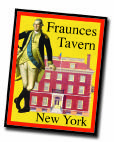
Wine trails are commonplace attractions now that every state in the union has wineries. Whiskey trails are another thing entirely.
In various states, tens of thousands of visitors annually visit various wineries that cooperate in tourist-oriented wine trail groupings. Each trail has its individual attractions, but all emphasize winery visits, festivals, B&Bs, dining, sight-seeing and the like.
Now, we have the American Whiskey Trail, a much longer trek to fewer places, but a fascinating concept nonetheless.
The new project, sponsored by the industry group known as the Distilled Spirits Council, includes seven historic sites and six operating whiskey distilleries spread over a five-state area from New York to Tennessee by way of Pennsylvania, Virginia and Kentucky.
If that seems a slightly awkward construct, perhaps it is. But it shows the erratic progression of whiskey making throughout America history.
From the north, the American Whiskey Trail begins at historic Fraunces Tavern Museum in Manhattan where Gen. George Washington (shown above) bade farewell to his troops in 1783 and ends at the site of the new George Washington Distillery Museum on the grounds of private citizen Washington's home at Mount Vernon, Va. There they refer to that site as the gateway to the trail. Geographic chauvinism obviously is dictated by where you live.
Distillers and wholesalers have do nated more than $1 million over the past four years to the Mount Vernon historic organization to reconstruct the once-bustling distillery at its original site. An interactive museum will be added by 2006.
Numerous historic stops on the Trail have a George Washington whiskey connection.
In addition to the spots already mentioned, the Trail includes Gadsby's Tavern Museum in Alexandria, Va., where early American leaders often met to discuss issues of the day and where at least twice Washington attended the annual Birthnight Ball held in his honor; Woodville Plantation in Allegheny County, Pa., built by Gen. John Neville, a Revolutionary War figure and close friend of Washington, and the Oliver Miller Homestead in South Park, Pa., which was a focal point of an 18th century dispute in which President Washington dispatched troops to enforce federal law taxing distilleries and whiskey.
Other historic sites are the Oscar Getz Museum in Bardstown, Ky., which has a collection of rare whiskey artifacts dating from pre-colonial to post-Prohibition days, and the West Overton Museums in Scottdale, Pa., a former distilliery center and part of what is billed as the only pre-Civil War village in Pennsylvania still intact.
Among the first Europeans to prac tice their whiskey making skills in this country were the Scotch-Irish of western Pennsylvania.
They were not alone in distilling whiskey, but they were among the feistiest and most productive. When the Continental Congress put a tax on whiskey production, they refused to pay, thus touching off the Whiskey Rebellion of 1791 to 1794.
So acrimonious was the dispute that President Washington sent troops to quell the uprising. When the whiskey makers continued to resist, he and Virginia Gov. Thomas Jefferson cooked up a deal to break up the concentration of resistance. Jefferson offered 60 acres of land as an incentive for moving to the Kentucky region (then part of Virginia), building a permanent structure and growing corn.
Many took advantage of the offer but found that no family could eat 60 acres' worth of corn a year, and it was too perishable to ship out for sale. The Scotch-Irish instead used it to make whiskey in place of much of the wheat and rye they were used to employing. Coincidentally, the presence of massive limestone for mations filtered and "sweetened" the water, which helped make a smoother distilled spirit, the one that came to be called bourbon for the Kentucky county in which it was produced.
The definition of whiskey, by the way, is a liquor produced from the fermented mash of grains such as barley, corn, and rye. That would include the likes of Canadian or Scotch whisky (no "e''), Irish whiskey, rye and bourbon.
Bourbon, however, is a special case. All bourbons are whiskies, but not all whiskies are bourbons. The legal definition of bourbon was codified in 1964 by a congressional resolution requiring that it be a minimum of two years old, at least 80 proof (40 percent alcohol), made from a mash of at least 51 percent corn, and aged in charred new oak bar rels, where the wood and the car bon give it that golden brown color and some of its flavor.
The operating distilleries open to the public as part of the Trail are Jim Beam in Clermont, Ky., Maker's Mark in Loretto, Ky., Wild Turkey in Lawrenceburg, Ky., Woodford Reserve in Versailles, Ky., George Dickel in Tullahoma, Tenn., and Jack Daniel's in Lynchburg, Tenn. It also includes two rum distilleries in Puerto Rico and the American Virgin Islands.
A touch of irony: Today, no bourbon is produced in Bourbon County.
For online information about historic sites on the American Whiskey Trail:
American Whiskey Trail
Fraunces Tavern Museum
Gadsby's Tavern Museum
Woodville Plantation
Oliver Miller Homestead
Oscar Getz Museum of Whiskey History
West Overton Museums
To Dowd's Spirits Notebook latest entry.
To Dowd's Wine Notebook latest entry.
To Dowd's Brews Notebook latest entry.
Back to Dowd's Bar Blog home page.
No comments:
Post a Comment